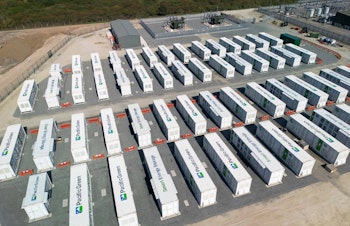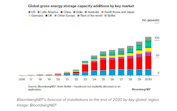
There is much to celebrate in BloombergNEF’s 2H 2023 Energy Storage Market Outlook, published in October. After three years of growth, the analyst firm believes energy storage deployments are on track to hit 42 GW and 99 GWh in 2023, a massive jump on 2022 levels.
The gigawatt-hour figure represents a 34% uplift on BloombergNEF’s previous forecast and is largely driven by capacity increases in China, where the firm expects 86% growth up to 2030 following new targets and a reform of national policy.

Based on current growth, global energy storage capacity could hit 650 GW and almost 1.9 TWh by 2030, BloombergNEF believes.
“Global energy storage’s record additions in 2023 will be followed by a 27% compound annual growth rate to 2030, with annual additions reaching 110 GW/372 GWh, or 2.6 times expected 2023 gigawatt installations,” says BloombergNEF.
“Targets and subsidies are translating into project development and power market reforms that favor energy storage,” it adds. “Our increase in deployments is driven by a wave of new projects prompted by energy shifting needs.
“Markets are increasingly seeking energy storage for capacity services (including through capacity markets). Japan, Poland, the UK, Chile, the US Southwest, New York and Australia are new markets opening up these opportunities.”
The figures do not include pumped hydro capacity, which topped 137 GW in 2022, but do cover a growing range of technologies beyond lithium-ion batteries.
“On the technology front, lithium-ion batteries using nickel manganese cobalt chemistries are losing market share due to their relatively higher cost when compared to lithium iron phosphate batteries,” the analyst firm says.
“Beyond lithium-ion batteries, alternative technologies focused primarily on long-duration energy storage needs remain limited, with 1.4 GW/8.2 GWh of commissioned capacity worldwide. The case for long-duration energy storage remains unclear despite a flurry of new project announcements.”
Who will lead global growth in energy storage?
As is the case for almost every low-carbon technology, China is set to lead global growth in energy storage by a wide margin. In a bid to ease interconnection issues, the country has mandated the use of storage alongside utility-scale wind and solar.
This requirement will help Asia Pacific (APAC) deliver 47% of all new energy storage capacity additions up to the end of the decade, BloombergNEF believes, although Australia, Japan and South Korea are also cited as markets to watch.
“Australia and Japan are both executing new capacity auctions for clean firm capacity which benefit energy storage installation by providing long-term capacity payments,” BloombergNEF says.
Also, it notes, “India’s new ancillary service product may provide opportunities for stationary storage in wholesale markets. We increased our cumulative deployment for APAC by 42% in gigawatt terms to 39 GW/105 GWh in 2030, largely due to China’s forecast outlook and methodology updates.”
Meanwhile Europe, Middle East and Africa are set to contribute 24% of new energy storage gigawatts added worldwide by 2030.
Residential battery installations in Germany and Italy took the analyst firm by surprise in 2022, helping deliver 4.5 GW and 7.1 GWh of new capacity across the region.
“Residential batteries are now the largest source of storage demand in the region and will remain so until 2025,” says BloombergNEF.

“Separately, over €1 billion ($1.1 billion) of subsidies have been allocated to storage projects in 2023, supporting a fresh pipeline of projects in Greece, Romania, Spain, Croatia, Finland and Lithuania.”
The UK, Germany, Italy, Greece and Turkey are expected to lead a tenfold increase in the gigawatts installed across Europe, Middle East and Africa through the rest of the decade, giving the region 114 GW and 285 GWh of capacity by the end of 2030.
This leaves the Americas lagging in terms of upcoming capacity additions, notwithstanding the US’s longstanding position as one of the biggest energy storage markets in the world. By 2030, BloombergNEF expects the region to have contributed 18% of new capacity in gigawatt terms.
“The geographical spread and broadening scope in activity across the US indicates it has become a mainstream resource for various US utilities’ decarbonization strategy,” BloombergNEF observes.
“Projects delayed due to higher-than-expected storage costs are finally coming online in California and the Southwest. Market reforms in Chile’s capacity market could pave the way for larger energy storage additions in Latin America’s nascent energy storage market.”
BloombergNEF’s forecast includes 9% of capacity—in gigawatt terms—as a buffer to cover markets where there is currently little visibility and the potential for more ambitious policies than those predicted.
“We based the buffer on battery shipment analysis, where we identified gaps in historical and near-term battery demand and applied that forward,” BloombergNEF says. “Based on our analysis, we added a buffer of 485 MW/1.9 GWh in 2022 and 1.9 GW/5.1 GWh in 2023.”
Even with the buffer, however, we view BloombergNEF’s predictions as conservative. Technology adoption usually follows an S curve, and this is not apparent from the capacity additions forecast from 2024 onwards.
Terawatt-hour levels of capacity
Worldwide, battery capacity will increasingly be needed to time-shift solar energy production, which is expected to soar.
The European industry body SolarPower Europe estimates there could be a terawatt of new solar being installed every year by the end of the decade, with 800 GW expected by 2027.
Because solar power production is limited to daylight hours and strongest at midday, batteries are key to using the zero-marginal-cost generation to meet evening and nighttime demand.
Batteries will also play an important role in helping new solar plants overcome grid constraints that SolarPower Europe says are already causing problems.
“Limited grid capacity, and a lack of flexibility or storage in national electricity systems, is posing a critical risk to the global solar transition,” says the association. “Out of the 26 significant solar countries, 20 report grid bottlenecks as a key barrier to solar development.”
Additional battery capacity will be needed for the decarbonization of road transport. Battery-enabled electric vehicle charging infrastructure is already a fixture of many road networks worldwide but must grow many times over to meet the needs of a fully electrified transport system.
With all these requirements, it might be that global battery storage capacity reaches terawatt-hour levels sooner than analysts expect.
Publish date: 12 March, 2024